Sometimes the best places to look for pheasants are in the strangest places. Here are five places that most hunters would never look for pheasants
By Jerry Thoms
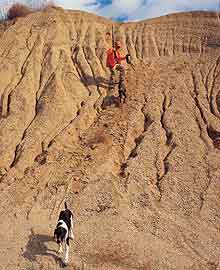 A sand and gravel pit may seem like one of the strangest places to hunt pheasants. Despite the lunar landscape look of these locations, there is often some ringneck-holding-cover in some secluded and hard-to-get-to part of the property. |
The traditional locations for hunting pheasants are easy to identify. Vast tracts of prairie grass, natural stands of marshlands, cultivated grain fields, and regular tree plots are among the most common spots in ringneck country to search for roosters.
There are other kinds of cover sites, however, where these wild birds hang out -- unusual bits and odd pieces of rural property we might all walk or drive by without realizing that maybe pheasants might be there. Peculiar places in some instances€¦in fact, far removed from the ordinary and familiar locations we call conventional pheasant habitat.
"Strange places," in other words, that once found and figured out could help make a day's good hunt great or a poor hunt better. Here are five places that most hunters would never consider as pheasant hideouts.
Find a Sand Pit
"If hunting ringnecks in sand and gravel pits was easy, every hunter would do it and there would be no pheasants out here," I assured my fellow rooster shooter for the third time as we and our dogs first climbed up and then slid down a man-made mountain of sand and gravel.
At the far end of this quarter-mile square complex of 30-foot-high hills and 50-foot-deep valleys was a little wet spot where wild sunflowers grew, surrounded by a ring of golden foxtail. A weed patch, in other words, where pheasants were protected by a wall of thick and tall vegetation all hidden a quarter mile from the main road.
Climbing up and sliding down these mounds of shifting sand and uncertain piles of loose stones was hard exercise that left us both breathless and sweaty by the time we got to the spot that we hoped would hold a rooster.
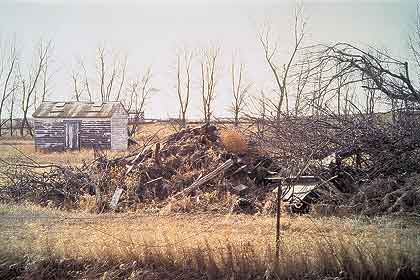 Old dump sites, where discarded home appliances, car bodies and other trash are piled, might also offer prime cover for ringnecks. The more difficult to find and get to, the more successful the hunt for pheasant can be in these strange places. |
"There's lots of pheasant tracks here," my buddy whispered as he pointed to a mish-mash of bird footprints, most of which were pointed toward the far end of the cover.
"Hen," I hollered out of habit and for no good reason as the obviously brown bird launched from the foxtail patch. Five more "ladies" followed the first one while my German shorthair stayed on a pretty point waiting for me to flush pheasant number seven.
"Hen? No it's a young rooster," we both decided. The short-tailed cock collapsed to a load of #6s.
Check Out Old Dump Sites
From a half-mile distance, these 10 acres of rural real estate don't look at all promising as a place to hunt pheasants. Up close, however, this now closed small town dump looks even worse -- rather destitute and forbidding, in fact, with defunct but still white refrigerators like discarded monoliths poking through ragged weed beds. And long-dead car bodies lying like rusty buffalo carcasses in chin-high prairie grass.
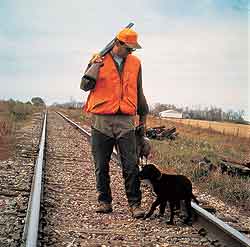 Active and abandoned railroad tracks are often bordered by miles and miles of excellent pheasant habitat. Often overlooked by hunters, these unusual places, found all over the country, may be open to hunting usually by permission only. |
I most often get suspicious looks from my hunting buddies the first time I take them to this strange place. Some of them have been around long enough, though, to believe there might be some method in the apparent madness of hunting pheasants in this forsaken piece of over-used and totally abused public property.
Despite the faintly lingering odor of rotten garbage and the eyesore landscape, the abandoned small town dump has been a honey hole of sorts for pheasants. The birds come here for the reasons hunters don't. The place is remote and empty to those who don't see the tall grass, the weedy edges, and all the short, dense shrubbery that give ringnecks a hiding place.
To get to the dump site, we need to park next to a busy highway, cross under an old stone bridge, then walk 300 yards to where the junk is piled next to a 200-acre cut cornfield and a 20-acre tree belt.
Sometimes pheasants are resting near the abandoned home appliances or close to the hulking car bodies. At other times, they are on the edge of the main dump site, hanging out in the corn stubble or by the tree line. Not all are roosters but enough have been to make the hunt here interesting and worth the time and effort. In five trips to the dump last season, we saw pheasants each time and took home three roosters.
Get On Track
There's always something a little spooky about hunting along railroad tracks because of the haunting prospect of a speeding diesel engine and a line of freight cars sneaking up behind us. No, this has never happened. After all, how could a couple thousand tons of clattering, earth-shaking, noise-belching metal creep up on any living thing along these narrow lines of iron?
Yet while hunting pheasants along a rail line, the image of a speeding train floats in and out of my head -- until my hunting partner's white English setter points a couple tight-sitting hens in the ditch 50 feet from the iron rails. Or another buddy's black English cocker plunges into a willow patch in a wet spot a stone's throw from the railroad bed and rousts up a rooster.
Hunt Dead
"The Cemetery Plot" is the obviously apt name we have given to the high stand of evergreens that conceal a clump of wild plum saplings growing along the backside of a country graveyard. When I first hunted pheasants at this strange place, I would park my truck along the road and walk the long route around the outside of the gravesite to get to the plum thicket.
Anyone wanting to hunt pheasants along railroad tracks needs to know the local regulations regarding public access to this kind of property. In some states, permission to trespass on these lands can be granted only by the owners of the railroad company.
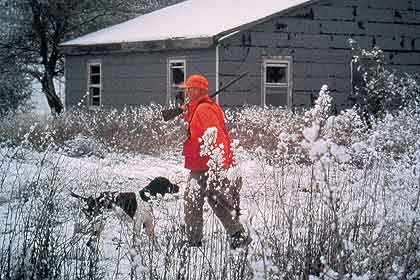 Abandoned farmsteads, set off from main roads and accessible only by long walks, often are surrounded by good habitat that will hold pheasants from early to late in the season. |
"Abandoned" railroad property, however, often reverts to the possession of adjacent landowners. Don't assume that any railroad can be hunted by anyone without permission.
So do ask before you enter, the same advice that applies to hunting any of the places mentioned in this article.
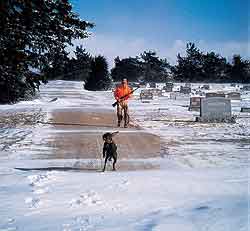 Country cemeteries, though usually carefully manicured, are often bordered by tree belts and natural prairie shrubbery which provide perfect cover for pheasants. |
As time went on, however, my strategy has been to drive right on in toward the center of the little cemetery, cut the engine at the entrance, and coast to a silent stop a hundred yards from the plum patch.
As quietly as possible, I drop the tailgate and let out the dogs, who by now know this routine. Without instruction, they heel up to the fence line, slip under the barbwire, and charge into the saplings.
Most of the time, a couple hens for sure and often a rooster will be there. The entire episode takes less than 30 minutes, but over several seasons more than a dozen ringnecks have died along the far edge of this cemetery.
The Old Rooster House
"See that abandoned farm yard? Yeah, the one that looks like a toy house and barn it's so far out in that pasture. Well, I walk out there every deer season to look for a big old buck that sometimes stays in the trees and grass behind the place.
"The last few years he hasn't been there. But, pheasants -- lots of pheasants -- have been. Why don't you get permission to hunt there and maybe you'll shoot a rooster."
My deer-hunting friend's tip has been good in the several times during various times of the last 12 seasons I've climbed over two barbwire fences and trudged the half mile to the tree stand and weed patches next to the old farmstead. Almost always pheasants have been there and half of these times roosters have been among the six to 10 birds my dogs and I find and flush out of the tall vegetation and old timber.
Conclusion
All of these places are "strange" to many hunters because they seem too small, too far out-of-the-way, too much work to get to, or too unlikely looking to produce pheasants. In most instances, only the most fanatical pheasant hunters and their dogs will go there to just "maybe" shoot a rooster.
Hunting in these "strange places" usually doesn't result in clouds of flushing pheasants.
Sometimes a few of these locations might not hold anything at all. But more often than not, and I haven't kept a close record of this, these special spots will produce a rooster or two to make the long and occasionally hard walks, often in hot or freezing or wet or windy weather, worth the effort.
"You can't count on making a 'steady living' hunting pheasants in these strange places," says one of my friends who goes after roosters in these sometimes offbeat and out-of-the-way locations. "But at those times when the standard pheasant hunting spots and conventional hunting methods may not produce much, the 'strangest places' can be the best spots."






